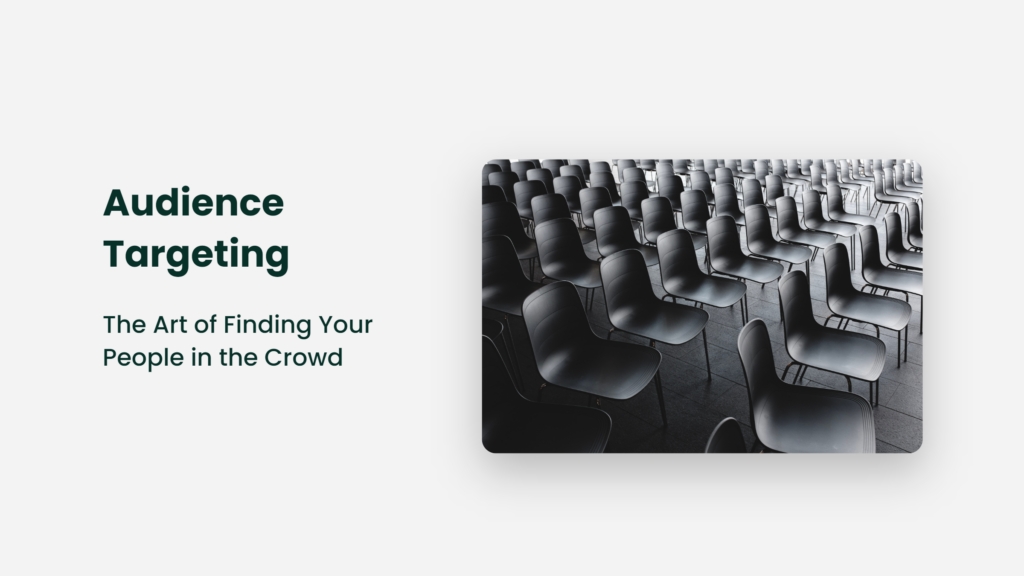Ah, the sweet melody of audience targeting. It’s like playing a harmonious symphony in a concert hall with listeners humming to your tune.

A Tale of Two Marketers
Let me share a story. Once upon a time, two marketers, Alice and Bob, each had a product to sell. Alice decided to cast a wide net, advertising her product to anyone with a pulse. On the other hand, Bob chose to hone in on a specific group he believed would be genuinely interested in his product. Guess who had better success?
Bob, our audience-targeting maestro, reaped the benefits of his selective approach. If you guessed Bob, you’d be spot on. But why did Bob’s approach work better? And how can we replicate his success?
The Power of Precision

In the vast ocean of consumers, it’s easy to feel like a tiny, insignificant fish. But remember, even the smallest fish can create ripples if it knows where to jump. Audience targeting is identifying and reaching specific groups of consumers within that ocean, typically based on various demographic, psychographic, and behavioural attributes. It’s all about precision, about finding that sweet spot in the sea where your ripples will have the most impact.
Why the One-Size-Fits-All Approach Doesn’t Cut It

Imagine being at a party where everyone is wearing the same outfit. It might be amusing at first, but it quickly becomes monotonous. This scenario is a metaphor for a one-size-fits-all marketing strategy. It could be more exciting and engaging. And more importantly, it fails to acknowledge our unique tastes and preferences.
As the great marketing pioneer John Wanamaker once said, “Half the money I spend on advertising is wasted; the trouble is, I don’t know which half.” Audience targeting seeks to solve this problem, ensuring that your marketing campaign reaches those most likely to resonate with your message.
Data: Your Crystal Ball

In the realm of audience targeting, data is like a crystal ball. It provides insights into your prospective customers’ preferences, behaviours, and needs. Google Analytics, Facebook Insights, and other data analytics platforms offer valuable information about your audience’s demographics, interests, online behaviour, and more.
But like any crystal ball, it’s not about what you see but how you interpret it. You could have all the data in the world, but you need a solid understanding of leveraging it to read tea leaves. So, how do we transform this data into actionable insights?
The Art of Segmentation: Divide and Conquer
The answer lies in Crystal Ball, dividing your audience into distinct groups based on shared characteristics. Segmentation allows you to conduct market research for each group’s unique needs and preferences, increasing the likelihood of engagement.
For instance, let’s say you’re marketing a new fitness app. Your messaging for a 20-year-old college student who loves high-intensity interval training (HIIT) will likely differ from a 50-year-old office worker looking for low-impact exercises. You could segment your audience based on age, fitness level, lifestyle, and preferred workout style.
Moving Beyond Demographics: Say Hello to Psychographics
While demographic information is crucial, effective audience targeting also considers psychographic data. Psychographics delve deeper into your audience’s lifestyle, values, attitudes, and interests. It’s the difference between knowing someone is a 30-year-old woman (demographics) and knowing she’s a 30-year-old woman who enjoys outdoor adventures, values sustainability, and is a Bear Grylls (psychographics) fan.
The Magic of Personalization

Now that you’ve segmented your audience and delved into psychographics, it’s time to personalize your marketing messages. Personalization is like composing a love song for each audience segment of your audience. It’s about making them feel seen, understood, and valued. Studies show that personalized emails, for example, have an open rate that is 29% higher than non-personalized emails and a click-through rate that is 41% higher.
Consider Netflix’s recommendation algorithm. It doesn’t recommend random shows; it suggests shows based on your viewing history, ratings, and preferences. This level of personalization makes the user feel understood and engaged, fostering a deeper connection with the platform.
Test, Test, and Test Again
Now, I know what you’re thinking. “This sounds great, but how do I know if my audience-targeting efforts work?” Well, my friend, the answer is simple. Test, test, and test again. Use A/B testing to compare different marketing strategies, analyze the results, and adjust your approach accordingly. Remember, audience targeting is an art, not a science, requiring a healthy dose of trial and error.
Audience Targeting: A Love Story
So there you have it, the beautiful tale of audience targeting. It’s a love story. A story about understanding your audience, reaching out to them with messages that resonate, and ultimately, forming a lasting bond. It’s about finding your people in the crowd and making sure they know you see them.
Let’s have a bit of fun. Below is a quick quiz to test your understanding of audience targeting.
Quiz:
Q1. Which marketer in our earlier story used audience targeting effectively?
a) Alice
b) Bob
Q2. What is the benefit of audience segmentation?
a) It allows you to wear cool glasses
b) It allows you to tailor your marketing messages to specific groups
Q3. What kind of data goes beyond demographics to understand the audience’s lifestyle and interests?
a) Astrological data
b) Psychographic data
Got your answers? The correct ones are: 1(b), 2(b), 3(b). I hope you were laughing if you chose any of the (a) options!
So the next time you find yourself lost in the sea of potential customers, remember the story of Alice and Bob. Hone in on your audience, craft resonating messages, and watch as your ripples create waves.
Frequently Asked Questions
Remember, the art to target audiences is about more than just selling a product; it’s about building a relationship with your audience. So, tune up your instruments, step onto the stage, and let the music play! When done right, it can transform your business, creating a symphony of engaged customers humming to your tune.
What is audience targeting?
Audience targeting uses data to segment your audience and customize your marketing efforts to each group’s unique needs and preferences.
Why is audience targeting important?
Audience targeting increases the effectiveness of your marketing efforts by ensuring that your messages reach the people most likely to be interested in your product or service.
How do I start with audience targeting?
Begin by collecting data on your audience, then segment your audience based on shared characteristics. Use these insights to personalize your marketing messages and test the effectiveness of your strategies.
What’s the difference between demographic and psychographic data?
Demographic data refers to objective characteristics such as age, gender, and income. Psychographic data explores aspects like lifestyle, values, interests, and attitudes.
What’s an example of target audience?
Netflix’s recommendation algorithm is a great example. It recommends shows based on each user’s viewing history and preferences, providing a personalized user experience.
Wrapping It Up
So, there you have it. A whimsical journey through the realm of audience targeting. It’s a world that’s more colourful and diverse than you might have initially imagined. A world filled not with faceless target consumers but individuals, each with unique tastes, preferences, and behaviours.
At its core, audience targeting is about respect. It’s about acknowledging your customers’ individuality and respecting their unique needs and preferences. It’s about communicating with them in a way that resonates, saying, “I see you. I understand you. I value you.”
So, the next time you’re crafting a marketing campaign, remember the story of Alice and Bob. Remember the power of precision, the magic of personalization, and the art of segmentation. Remember that even the smallest fish can create ripples in the vast ocean of consumers if it knows where to jump.
And remember, my dear reader, that exact audience targeting isn’t just a strategy; it’s an art. An art that, when mastered, can turn the humdrum monologue of traditional marketing into a vibrant, engaging dialogue. So, don your artist’s hat, pick up your data palette, and start painting. The canvas of your audience awaits.




